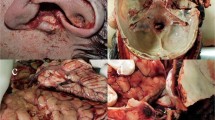Summary
1. The “growing skull fracture” (Pia and Tönnis, 1953) is an uncommon result of a sometimes apparently minor head injury in children up to about 3 years of age. The primary lesion is a linear fracture of the calvarium associated with a ruptured dura mater and a localised soft swelling of the scalp beneath the intact skin. The subsequent widening of the fracture cleft, the typical osseous changes, the characteristic x-ray findings which may be observed for years or decades, and the neurological complications all add up to a well defined clinical picture although the pathogenesis may be variable in individual cases (Case 2).
2. The posttraumatic increase of intracranial pressure is one of the most important pathogenetic factors. As an example the case of a severe closed head injury is described (Case 1). The child aged 2 years and 10 months had neither sustained a fracture of the skull nor a ruptured dura, still after the trauma had subsided there were signs of progressive increase of the intracranial pressure which eventually produced distended cranial sutures. Death occurred 102 days after the accident, and an extreme hydrocephalus internus and widespread pressure necroses symmetrical in the cerebral cortex were revealed on postmortem examination. The hydrocephalic increase of pressure is best explained as being due to a profound discrepancy between the production and reabsorption of cerebrospinal fluid, presumably as a sequela of subarachnoid hemorrhages caused by the trauma. We believe that a mechanism of this type plays an important if not decisive role in the pathogenesis of the “growing skull fracture.”
3. If this is true the therapeutic approach during the early stages would include measures to keep the intracranial pressure down continuously for a long period of time. The scalp swelling should not be punctured as a porus might develop when the prolapsed brain tissue is pierced. In the later stages the patients often consult the neurologist for their history of convulsions, and roentgenological evidence of a growing skull fracture will be found. Pneumencephalography is not indicated.
Zusammenfassung
1. Die „wachsende Schädelfraktur des Kindesalters“ (Pia u. Tönnis, 1953) ist eine seltene Folge von scheinbar geringfügigen Schädel-Hirn-Traumen bei Kleinkindern bis zum Alter von etwa 3 Jahren. Es kommt hierbei zu einer linearen Konvexitätsfraktur mit Zerreißung der Dura und umschriebener Weichteilschwellung bei intakter Haut. Die konsekutive Verbreiterung des Frakturspaltes, die typischen Knochenveränderungen, der charakteristische, nach Jahren und Jahrzehnten noch nachweisbare Röntgenbefund und die neurologischen Folgen bilden ein wohlumschriebenes, pathogenetisch vielschichtiges Krankheitsbild (Fall 2).
2. Unter den verschiedenen pathogenetischen Faktoren hat die posttraumatische Hirndrucksteigerung besondere Bedeutung. Dies wird am Beispiel eines Falles von hochgradiger traumatischer Hirnschädigung erörtert. Das fast 3 Jahre alte Kind erlitt keine Schädelfraktur und keine Duraverletzung, zeigte aber im Anschluß an das Trauma die Zeichen einer zunehmenden intrakraniellen Drucksteigerung, die zuletzt die Schädelnähte sprengte. Tod 102 Tage nach dem Unfall. Es fanden sich ein extremer Hydrocephalus internus und ausgedehnte symmetrische Drucknekrosen der Großhirnrinde (Fall 1). Ein schweres Mißverhältnis zwischen Liquorproduktion und Liquorresorption, hauptsächlich ausgelöst durch die traumatische Subarachnoidalblutung, erklärt die hydrocephale Drucksteigerung am besten. Wir meinen, daß ein vergleichbarer Mechanismus bei der „wachsenden Fraktur“ entscheidende Bedeutung hat.
3. Die wesentliche therapeutische Konsequenz wären dann im Frühstadium Maßnahmen, die eine kontinuierliche Druckentlastung über längere Zeit gewährleisten. Punktionen der Weichteilschwellungen sollten aber wegen der Gefahr weiterer Schädigung eines prolabierten Hirngewebes (Porusbildung!) vermieden werden. — Im Spätstadium, das häufig erst wegen cerebraler Anfälle aufgedeckt wird, sollte eine Pneumencephalographie unterbleiben.
Similar content being viewed by others
Literatur
Arseni, C., Simionescu, M.D.: Growing skull fractures of childhood. A particular form of posttraumatic encephalopathy. Acta neurochir. (Wien) 15, 159–172 (1966).
Jenkins, R.: Paraventricular porencephalic diverticulum with latent hemiparesis as a complication of ventriculography. J. Neurol. Neurosurg. Psychiat. 30, 261–263 (1967).
Jungklaass, F. K.: Ein Ohrhöhenmesser mit Orbitalwinkel. Z. menschl. Vererb.- u. Konstit.-Lehre 37, 300–304 (1964).
Klar, E., Piotrowski, W.: Zur Problematik der wachsenden Schädelfraktur. Langenbecks Arch. klin. Chir. 316, 381–384 (1966).
Koeppen, A. H. W., Barron, K. D.: Superficial siderosis of the central nervous system. A histological, histochemical and chemical study. J. Neuropath. exp. Neurol. 30, 448–469 (1971).
Lende, R. A., Erickson, Th. C.: Growing skull fractures of childhood. J. Neurosurg. 18, 479–489 (1961).
Lévy, A., Simon, P.: Les lacunes craniennes après traumatisme de la première enfance. J. Radiol. Électrol. 37, 926–929 (1956).
Müller, K., Kohlheb, O.: Über Hirnsubstanzschädigungen bei Ventrikulographie. Ein Beitrag zur Punktions-Porenzephalie. Z. Kinderheilk. 103, 28–34 (1968).
Noetzel, H.: Diffusion von Blutfarbstoff in der inneren Randzone und äußeren Oberfläche des ZNS bei subarachnoidaler Blutung. Arch. Psychiat. Nervenkr. 111, 129–139 (1940).
Noetzel, H., Jerusalem, F.: Die Hirnvenen- und Sinusthrombosen. In: Monogr. ges. Neurol. Psychiat., Bd. 106. Berlin-Heidelberg-New York: Springer 1965.
Peters, E.: Klinische Neuropathologie. In: Spez. Path. Krankh. zentralen Nervensystems, 2. Aufl. Stuttgart: Thieme 1970.
Pia, H. W.: Zur Pathogenese und Frühbehandlung der „wachsenden Schädelfraktur des Kindesalters“. Dtsch. Z. Nervenheilk. 172, 1–11 (1954).
Pia, H. W.: Hirnverletzungen bei Kindern und ihre akuten Komplikationen. Münch. med. Wschr. 108, 760–768 (1966).
Pia, H. W., Tönnis, W.: Die wachsende Schädelfraktur des Kindesalters. Zbl. Neurochir. 13, 1–23 (1953).
Rosenthal, P.: Siderose der Randzonen des Zentralnervensystems. Dtsch. Z. Nervenheilk. 178, 431–472 (1958).
Testa, C., Nizzoli, V.: Fractures évolutives dans les traumatismes crâniens fermés de la première enfance aboutissant à la constitution d'une lacune cranienne. Neuro-chirurgie 14, 111–134 (1968).
Weitere Literatur auf Anforderung.
Author information
Authors and Affiliations
Additional information
Frau Professor Dr. med. Herta Lange-Cosack zum 9. Oktober 1972 für ihr unermüdliches Wirken im Kampf gegen die Folgen des kindlichen Hirntraumas.
Auszugsweise vorgetragen auf der Wochenendsitzung der Niedersächsischen Röntgengesellschaft am 1. 2. 1969 in Bremen.
Für die Untersuchung standen Mittel der Stiftung Volkswagenwerk zur Verfügung.
Rights and permissions
About this article
Cite this article
Döpper, T., Spaar, F.W. & Orthner, H. Zur Neuropathologie des posttraumatischen Hirndrucks im Kindesalter. Z. Neurol. 202, 37–51 (1972). https://doi.org/10.1007/BF00316424
Received:
Issue Date:
DOI: https://doi.org/10.1007/BF00316424




